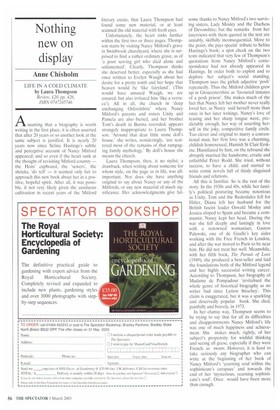Nothing new on display
Anne Chisholm
LIFE IN A COLD CLIMATE by Laura Thompson Review, £20, pp. 426. ISBN 0747245746 Assuming that a biography is worth writing in the first place, it is often asserted that after 20 years or so another look at the same subject is justified. It is nearly 20 years now since Selina Hastings's subtle and perceptive account of Nancy Mitford appeared: and so even if the heart sank at the thought of revisiting Mitford country — the Hons' cupboard, the 'sewers', the shrieks, 'do tell' — it seemed only fair to approach this new book about her in a positive, hopeful spirit. After all, it was possible, if not very likely given the assiduous cultivation in recent years of the Mitford
literary estate, that Laura Thompson had found some new material, or at least scanned the old material with fresh eyes.
Unfortunately, the heart sinks further within the first two or three pages. Thompson starts by visiting Nancy Mitford's grave in Swinbrook churchyard, where she is surprised to find a rather ordinary grave, as of 'a poor serving girl who died alone and unlamented'. Clearly, Thompson thinks she deserved better, especially as she had once written to Evelyn Waugh about her desire for a pretty tomb and her hope that heaven would be 'like fairyland'. (This would have amused Waugh, we are assured, but also irritated him 'like a verruca'). All in all, the church in 'deep unchanging Oxfordshire' where Nancy Mitford's parents and sisters Unity and Pamela are also buried, and her brother Tom's death in Burma recorded, appears strangely inappropriate to Laura Thompson. 'Around that dear little stone doll's house,' she writes, wonderingly. 'are scattered most of the remains of that rampaging family mythology.' By doll's house she means the church.
Laura Thompson, then, is no stylist; a drawback, when writing about someone for whom style, on the page as in life, was allimportant. Nor does she have anything original to say about Nancy or any of the Mitfords, or any new material of much significance. Her acknowledgments give ful
some thanks to Nancy Mitford's two surviving sisters, Lady Mosley and the Duchess of Devonshire; but the remarks from her interviews with them quoted in the text are amiably, skilfully inconsequential. More to the point, she pays special tribute to Selina Hastings's book; a spot check on the two texts indicated that very few of Thompson's quotations from Nancy Mitford's correspondence had not already appeared in Hastings. In order both to exploit and to deplore her subject's social standing, Thompson uses the girlish adjective 'posh' repeatedly. Thus the Mitford children grew up in Gloucestershire as 'favoured inmates of a posh prison'. She makes much of the fact that Nancy felt her mother never really loved her, as Nancy said herself more than once in her later writings. Nancy's love of teasing and her sharp tongue were, predictably enough, her way of asserting herself in the joky, competitive family circle. Too clever and original to marry a conventional man, her first love was a charming, childish homosexual, Hamish St Clair Erskine. Humiliated by him, on the rebound she abruptly married the handsome, erratic and unfaithful Peter Rodd, She tried, without success, to have a child, and started to write comic novels full of thinly disguised friends and relations.
All this is familiar. So is the rest of the story. In the 1930s and 40s, while her family's political posturing became notorious as Unity, Tom and the Redesdales fell for Hitler, Diana left her husband for the British fascist leader Oswald Mosley and Jessica eloped to Spain and became a communist, Nancy kept her head. During the war she fell deeply and lastingly in love with a renowned womaniser, Gaston Palewski, one of de Gaulle's key aides working with the Free French in London, and after the war moved to Paris to be near him. He did not treat her well. Meanwhile, with her fifth book, The Pursuit of Love (1949), she produced a best-seller and laid the foundations both of the Mitford legend and her highly successful writing career. According to Thompson, her biography of Madame de Pompadour 'revitalised the whole genre of historical biography as no writer had since Lytton Strachey'. This claim is exaggerated, but it was a sparkling and deservedly popular book. She died, painfully and bravely, in 1973.
In her clumsy way, Thompson seems to be trying to say that for all its difficulties and disappointments Nancy Mitford's life was one of much happiness and achievement. She makes much, rightly, of her subject's propensity for wishful thinking and seeing all geese, especially if they were French, as swans. However, it is hard to take seriously any biographer who can write at the beginning of her book of Nancy Mitford's 'yearning soul within the sophisticate's carapace' and towards the end of her 'mysterious, yearning sophisticate's soul'. Once would have been more than enough.


















































































 Previous page
Previous page